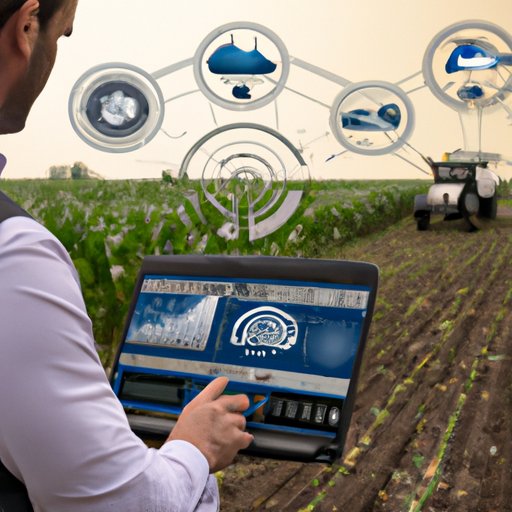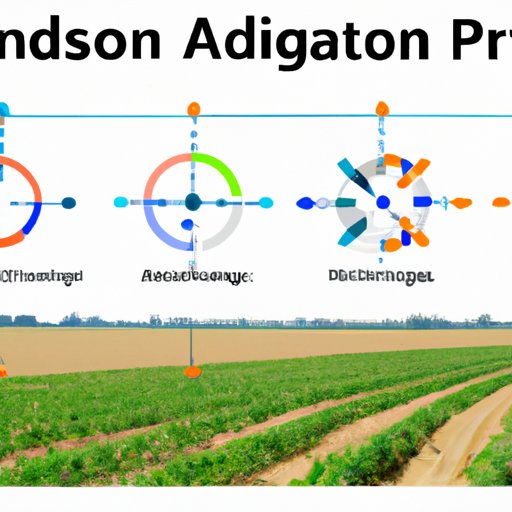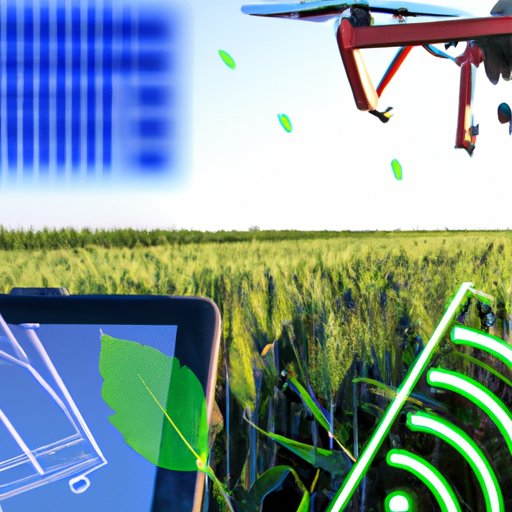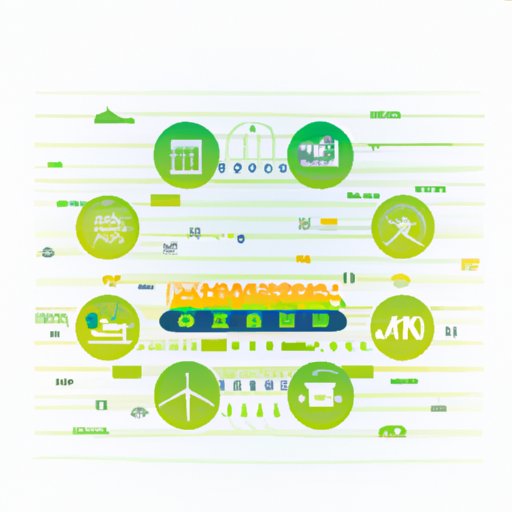Introduction
Precision agriculture technology is an innovative approach to farming that uses advanced technologies and data-driven decision making to optimize crop production and increase efficiency. By leveraging the power of sensors, automation, and big data analytics, precision agriculture technology helps farmers make informed decisions about their crops and operations. This technology has revolutionized the way farmers manage their resources, leading to increased crop yields, improved efficiency, reduced costs, and improved sustainability.
Examining the Benefits of Precision Agriculture Technology
Precision agriculture technology offers a number of key benefits to farmers, including increased crop yields, improved efficiency, reduced operating costs, and improved sustainability. Here, we examine each of these benefits in more detail.
Increased Crop Yields
One of the primary benefits of precision agriculture technology is the ability to increase crop yields. Studies have shown that this technology can improve crop yields by up to 20%. For example, according to a study conducted by the International Journal of Agricultural and Biological Engineering, precision agriculture technology can help increase wheat yields by up to 19%. This technology gives farmers the ability to monitor and control their crops more effectively, allowing them to make informed decisions that can maximize yield potential.
Improved Efficiency
In addition to increased crop yields, precision agriculture technology also improves efficiency. This technology enables farmers to use resources more efficiently, reducing the amount of time, energy, and money required to grow their crops. By automating processes such as irrigation, fertilization, and pest control, farmers can save time and money while improving their operational efficiency.
Reduced Operating Costs
Using precision agriculture technology also reduces operating costs. By optimizing processes such as fertilization and irrigation, farmers can reduce the amount of inputs used, resulting in lower overall costs. Additionally, this technology can help farmers reduce labor costs by automating tasks such as planting and harvesting.
Improved Sustainability
Finally, precision agriculture technology improves sustainability by reducing the environmental impact of farming. By using fewer inputs and utilizing natural resources more efficiently, this technology helps farmers reduce their carbon footprint. Additionally, it helps farmers identify and address areas where their practices are not sustainable, allowing them to make changes that can lead to long-term improvements in their operations.

Exploring the Applications and Uses of Precision Agriculture Technology
Precision agriculture technology has a wide range of applications and uses. Here, we explore four of the most common uses of this technology.
Variable Rate Application
Variable rate application is one of the most popular uses of precision agriculture technology. This technology allows farmers to apply different amounts of inputs, such as fertilizer, water, and pesticides, at different points in a field. This helps farmers reduce input costs and improve the efficiency of their operations. Additionally, variable rate application can help farmers reduce their environmental impact by minimizing the amount of inputs used.
Remote Sensing
Remote sensing is another popular application of precision agriculture technology. This technology uses sensors and cameras to collect data from fields, giving farmers an accurate picture of their crops. This data can be used to identify areas of stress or pest infestations, allowing farmers to take prompt action to address the issue. Additionally, remote sensing can provide valuable insights into soil composition, topography, and other factors that can affect crop growth.
Automated Machinery
Automated machinery is another key application of precision agriculture technology. This technology allows farmers to automate processes such as planting, harvesting, and irrigation, saving time and labor costs. Additionally, automated machinery can help farmers reduce their environmental impact by reducing fuel consumption and emissions.
Data Collection and Analysis
Finally, precision agriculture technology allows farmers to collect and analyze large amounts of data. This data can be used to track crop health, monitor water usage, identify areas of stress, and more. By leveraging the power of big data analytics, farmers can gain valuable insights into their operations and make informed decisions that can maximize yields and reduce costs.
Investigating the Challenges of Implementing Precision Agriculture Technology
While precision agriculture technology offers a number of benefits, there are also some challenges associated with its implementation. Here, we look at three of the most common challenges faced by farmers when implementing this technology.
Cost of Technology
The cost of precision agriculture technology can be a barrier for many farmers. While this technology offers a number of benefits, it can be expensive to implement, especially for smaller farms. Additionally, some farmers may not have access to financing or other resources needed to purchase the necessary equipment.
Availability and Access to Data
Another challenge faced by farmers when implementing precision agriculture technology is access to data. In order to make the most of this technology, farmers need access to accurate and up-to-date data. However, in some cases, this data may be difficult or expensive to obtain.
Complexity of Implementation
Finally, the complexity of implementation can be a challenge for many farmers. Precision agriculture technology requires a significant investment of time, energy, and resources to implement successfully. Additionally, farmers need to have a basic understanding of the technology and its various applications in order to make the most of it.

A Guide to Choosing the Right Precision Agriculture Technology for Your Farm
When choosing a precision agriculture technology for your farm, there are several factors to consider. Here, we provide a guide to help you choose the right technology for your needs.
Identify Your Goals
The first step in choosing the right precision agriculture technology for your farm is to identify your goals. Ask yourself what you want to achieve with this technology. Are you looking to increase yields? Reduce costs? Improve sustainability? Once you have identified your goals, you can begin researching products that can help you meet those goals.
Research and Compare Products
Once you have identified your goals, the next step is to research and compare products. Look for products that offer features that can help you meet your goals. Consider factors such as cost, ease of use, accuracy, and customer reviews. Additionally, reach out to other farmers who have implemented this technology to get their feedback on different products.
Consider Costs and Resources
Finally, it is important to consider the costs and resources required to implement this technology. Make sure you understand the upfront costs as well as any recurring costs such as maintenance and data fees. Additionally, consider the time and resources required to install and maintain the technology. By taking these factors into account, you can ensure that you choose the right technology for your farm.
Evaluating the Cost-Effectiveness of Precision Agriculture Technology
Once you have chosen the right precision agriculture technology for your farm, it is important to evaluate its cost-effectiveness. Here, we provide a guide to help you determine whether this technology is worth the investment.
Calculate Return on Investment
The first step in evaluating the cost-effectiveness of precision agriculture technology is to calculate your return on investment (ROI). Calculate your total costs for purchasing and implementing the technology and compare it to the expected benefits. This will give you an indication of whether this technology is likely to be profitable for your farm in the long term.
Analyze Data and Results
It is also important to analyze the data and results of your precision agriculture technology. Track the performance of your crops and compare it to previous years. This will help you identify areas where the technology is having a positive effect and areas where it needs improvement. Additionally, analyze the data collected by the technology to gain valuable insights into your operations.
Understanding the Impact of Precision Agriculture Technology on Yields
Precision agriculture technology can have a significant impact on yields. Here, we look at two of the ways this technology can improve crop yields.
Improved Management of Inputs
One of the primary benefits of precision agriculture technology is improved management of inputs. This technology enables farmers to apply inputs such as fertilizer and water more accurately and efficiently. By reducing input waste, farmers can maximize yield potential and reduce costs.
Optimized Use of Resources
Precision agriculture technology also enables farmers to optimize the use of resources. This technology provides valuable data that can help farmers make informed decisions about their crops. Additionally, this technology can help farmers identify areas of stress or pest infestations, allowing them to take prompt action to address the issue.

Analyzing the Future of Precision Agriculture Technology
The future of precision agriculture technology looks bright. As technology continues to evolve, this technology is likely to become increasingly widespread. Here, we look at three potential impacts of this trend.
Impact of Emerging Technologies
As new technologies emerge, they are likely to have a significant impact on precision agriculture technology. Artificial intelligence, machine learning, and robotics are all likely to have an impact on this technology, enabling farmers to automate processes and gain valuable insights into their operations. Additionally, these technologies could enable farmers to reduce costs and increase efficiency.
Potential Applications
The potential applications of precision agriculture technology are vast. From monitoring crop health to optimizing irrigation systems, this technology can be used to improve a variety of processes. Additionally, this technology could be used to develop new methods of crop production, such as precision livestock farming and vertical farming.
Increased Adoption Rates
Finally, it is likely that adoption rates of precision agriculture technology will continue to increase. As technology becomes more accessible and affordable, more farmers are likely to adopt this technology. Additionally, government incentives and public awareness campaigns could further increase adoption rates.
Conclusion
Precision agriculture technology offers a number of benefits to farmers, including increased crop yields, improved efficiency, reduced costs, and improved sustainability. This technology also has a wide range of applications, from variable rate application to data collection and analysis. However, there are some challenges associated with its implementation, such as the cost of the technology and the complexity of implementation. Finally, it is important to evaluate the cost-effectiveness of the technology before implementing it and to analyze the data and results to ensure it is meeting your goals. Overall, precision agriculture technology is an invaluable tool for farmers, providing a wealth of benefits and potential applications.
(Note: Is this article not meeting your expectations? Do you have knowledge or insights to share? Unlock new opportunities and expand your reach by joining our authors team. Click Registration to join us and share your expertise with our readers.)
